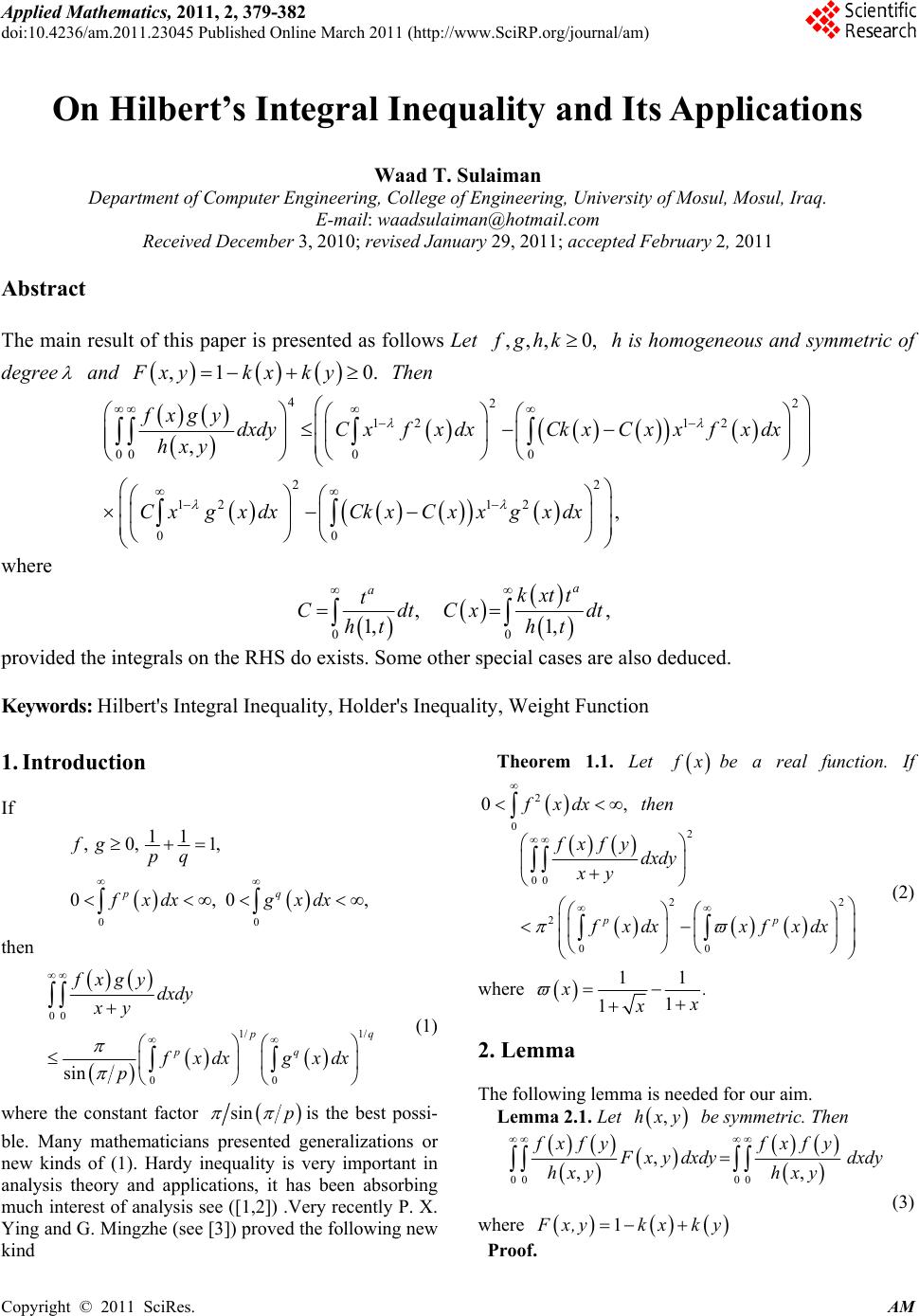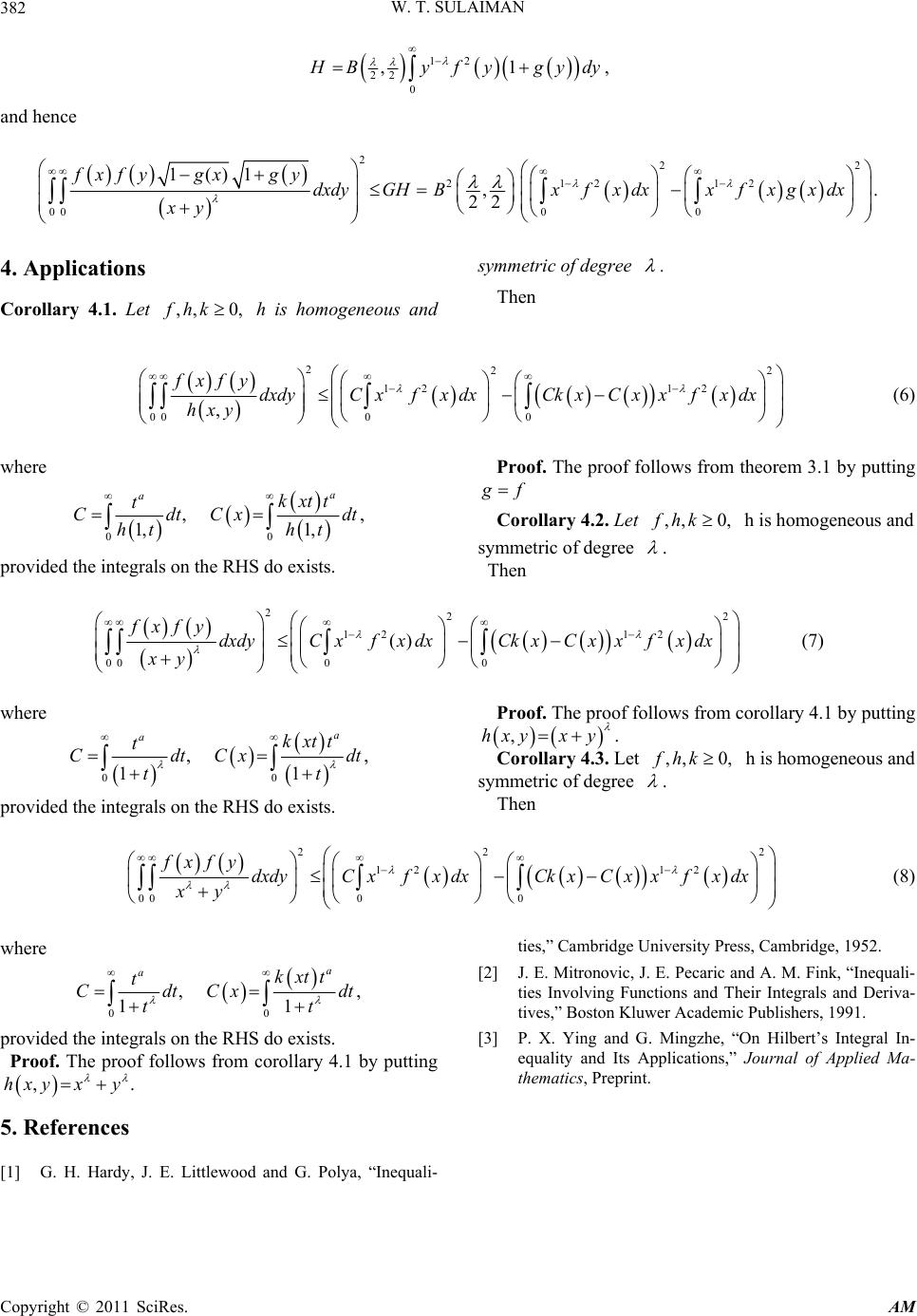Paper Menu >>
Journal Menu >>
 Applied Mathematics, 2011, 2, 379-382 doi:10.4236/am.2011.23045 Published Online March 2011 (http://www.SciRP.org/journal/am) Copyright © 2011 SciRes. AM On Hilbert’s Integral Inequality and Its Applications Waad T. Sulaiman Department of Computer Engineering, College of Engineering, University of Mosul, Mosul, Iraq. E-mail: waadsulaiman@hotmail.com Received December 3, 2010; revised January 29, 2011; accepted Febru ar y 2, 2011 Abstract The main result of this paper is presented as follows Let ,,, 0,fghk h is homogeneous and symmetric of degree and ,1 0.Fxykx ky Then 422 12 12 000 0 22 12 12 00 , , fxgydxdyCxfx dxCkxCxxfx dx hxy CxgxdxCkx Cxxgxdx where 00 ,, 1, 1, a akxtt t CdtCx dt ht ht provided the integrals on the RHS do exists. Some other special cases are also deduced. Keywords: Hilbert's Integral Inequality, Holder's Inequality, Weight Function 1. Introduction If 00 11 ,0, 1, 0,0, pq fg pq fxdx gxdx then 00 1/ 1/ 00 sin p q pq fxgy dxdy xy f xdxg xdx p (1) where the constant factor sin p is the best possi- ble. Many mathematicians presented generalizations or new kinds of (1). Hardy inequality is very important in analysis theory and applications, it has been absorbing much interest of analysis see ([1,2]) .Very recently P. X. Ying and G. Mingzhe (see [3]) proved the following new kind Theorem 1.1. Let f xbe a real function. If 2 0 0,fxdx then 2 00 22 2 00 pp fxfy dxdy xy fxdx xfxdx (2) where 11 1 1 x . x x 2. Lemma The following lemma is needed for our aim. Lemma 2.1. Let ,hxy be symmetric. Then 00 00 , ,, fxfy fxfy F x ydxdydxdy hxy hxy (3) where 1 F x,yk xky Proof.  W. T. SULAIMAN Copyright © 2011 SciRes. AM 380 00 00 00 0000 00 0000 00 ,1 ,, ,, , ,, , ,, fxfyfxfy Fx ydxdykxkydxdy hxy hxy fxfyfxfykx fxfyky dxdy dxdydxdy hxy hxyhxy fxfy fxfykxfyfxkx dxdy dxdydydx hxy hxyhyx fxfyfxfykx dxdy hxy hxy 00 0000 ,, fxfykx fxfy dxdydxdy dxdy hxy hxy The object of this paper is to present the following gen- eral result 3. Main Results Theorem 3.1. Let ,,, 0,fghk h is homogeneous and symmetric of degree and ,1 0Fxykxky . Then 422 12 12 000 0 22 12 12 00 , , fxgydxdyCxfxdxCkxCxxfxdx hxy CxgxdxCkx Cxxgxdx (4) where 00 ,, 1, 1, a akxtt t CdtCx dt ht ht provided the integrals on the RHS do exists. Proof. 0000 1/21/2 22 00 00 ,, , ,,, ,, . ,, fx Fxygy Fxy fxgyFxy dxdy dxdy hxy hxy hxy fxFxy gyFxy dxdydxdyMN hxy hxy /2 /2 00 1/21/2 22 12 00 00 ,, ,, ,, . ,, a a aa fx Fxyfx Fxy yx Mdxdy xy hxy hxy fxFxy fxFxy yy dxdydxdyM M hxy xhxy x 2 22 100000 0 12 12 0000 12 12 00 11 (, ),, () 1() 1,(1, ) . aa a aa fx kxkyyxky yx y M dxdyf xkxdydxfxdydx hxyxhxyhxy uukxu xkxfxdudxxfxdudx hu hu CxfxdxCkxCxxfxdx  W. T. SULAIMAN Copyright © 2011 SciRes. AM 381 Similarly, 12 12 200 . M CxfxdxCkxCx xfxdx Therefore 2 212 0 2 12 0 , MCxfxdx CkxCxxfx dx and 2 212 0 2 12 0 . NCxgxdx CkxCxxgx dx Applying lemma 2.1 to have 44 00 00 22 12 12 00 22 12 12 00 , ,, . fxgy fxgyFxy dxdy dxdy hxy hxy CxfxdxCkxCx xfxdx CxgxdxCkx Cxxgxdx Remark. It may be mentioned that theorem 1.1 follows from corollary 4.1 by putting ,,12,1,()11hxyx y akxx as follows 12 2 00 2 11 / udu Cdu uu . 2 1/2 2 00 () 11 kxu kxuu C xdudu uu 22 0 , 1 11 du x xu u and 11 11 Ck xC xx x Theorem 3.2. Let 0,01,0.fg Then 222 212 12 22 00 00 11 ,. fxfygxgydxdyBxf xdxxf xgxdx xy (5) Proof. 1 142 42 /2 /2 00 00 1/2 1/21 22 12 2 00 00 111 1 11 . fxfy gxgyfx gxfygy yx dxdy dxdy xy xyxy xy fx gxfygy yx dxdydxdyG H xy xy xy 11 1 22 22 12 22 0000 0 () 11,1 1 yxx t GfxgxdydxfxgxdtdxB xfxgxdx xy t Similarly  W. T. SULAIMAN Copyright © 2011 SciRes. AM 382 12 22 0 ,1 H Byfygydy , and hence 222 212 12 00 00 1()1,. 22 fxfygxgydxdyGHBxfx dxxfxgxdx xy 4. Applications Corollary 4.1. Let ,, 0,fhk h is homogeneous and symmetric of degree . Then 222 12 12 000 0 , fxfy dxdyCxfxdxCkxCxxfxdx hxy (6) where 00 ,, 1, 1, a akxtt t CdtCx dt ht ht provided the integrals on the RHS do exists. Proof. The proo f follows from theo rem 3.1 by putting g f Corollary 4.2. Let ,, 0,fhk h is homogeneous and symmetric of degree . Then 222 12 12 0000 () fxfydxdyCxfxdxCkxCxxfx dx xy (7) where 00 ,, 11 a akxtt t CdtCxdt tt provided the integrals on the RHS do exists. Proof. The proof follows from corollar y 4 .1 by pu tting ,.hxyx y Corollary 4.3. Let ,, 0,fhk h is homogeneous and symmetric of degree . Then 222 12 12 0000 fxfydxdyCxfx dxCkxCxxfxdx xy (8) where 00 ,, 11 a akxtt t CdtCxdt tt provided the integrals on the RHS do exists. Proof. The proof follows from corollary 4.1 by putting ,.hxy xy 5. References [1] G. H. Hardy, J. E. Littlewood and G. Polya, “Inequali- ties,” Cambridge University Press, Cambridge, 1952. [2] J. E. Mitronovic, J. E. Pecaric and A. M. Fink, “Inequali- ties Involving Functions and Their Integrals and Deriva- tives,” Boston Kluwer Academic Publishers, 1991. [3] P. X. Ying and G. Mingzhe, “On Hilbert’s Integral In- equality and Its Applications,” Journal of Applied Ma- thematics, Preprint. |

